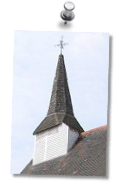St. Mary the Virgin Little Burstead

A Brief history of St. Mary the Virgin
The church of St. Mary the virgin is set in a picturesque, but isolated rural situation on high ground overlooking the Thames valley. Holly trees surround the churchyard and were a gift from Miss Archer, a local resident. They were planted about 1900 for the purpose of feeding the birds.
Always a modest settlement, Little Burstead still enjoys a village atmosphere. In King Edward's time it had been held by Godwin, but is mentioned in the Domesday Book and was held at that time by the Bishop of London whereas much of the local land appears to have been owned by William's half brother, 0do Bishop of Bayeaux.
Located back to front?
A probable explanation for the present isolated position of the Church might be explained by looking further back in history than the modern site of the village and considering that the back of the Church was in fact 'the front'. The road that now leads to the Church probably did not exist at the time it was built and the main route from Billericay ran from Tye Common, through Wiggins Lane, across to Hatches Farm road and up Botney Hill towards Herongate. Three manors were sited between Botney Hill and the Dunton road and standing in this area one can see that the Church is positioned so that it overlooks the area that it probably served.
Building phases and materials used
The Church was built in late Norman times as a windowed oratory and was originally much smaller. The roof of the Nave would have been much lower and the door was on the north side opposite the present South door which is 15th Century. The Altar was almost certainly sited in the recess to the side of the present pulpit. Extensive alterations would have occurred when the Chancel was added in the mid 14th Century. The walls of the Church are built of ragstone rubble and of 'pudding stone' (a conglomerate of pebbles in a siliceous matrix found locally) with limestone and brick dressing. Its composition can be observed in the North wall but other walls were plastered over in the 1950s and 1960s as a serious weathering had taken place. The round stones on either side of the Porch are probably the base of a Churchyard calvary. The South door is 15th Century and the Porch was added much later.
The Font is early 16th Century.
The Gallery was added in 1880 and beyond this adjoining the North wall is the toilet extension which was completed in 1990.
Church layout
The Nave shows several windows in various styles from different periods in the Church's history. The South window is 16th Century The stained glass in the North window depicting Apostles, is probably Flemish 17th Century. The window above the Pulpit shows the Coat of Arms of the Walton family, many of whose tombs are in the Sanctuary, Chancel and Nave. To the right of the Chancel entrance may be seen the remains of mediaeval frescoes decorating the old entrance to the rood loft. The carved corbels at the base of the main beam were probably mutilated in Cromwell's time.
Ahead lies the Chancel, which is mid 14th Century except the South wall which was reconstructed in the 15th Century and shows a connection with the Tyrell family. The door is now bricked up. The stained glass window in the East wall above the Altar is in memory of John Ismay French who died in 1893. Of special interest are the Aumbry which formerly contained the reserved sacrament and is of unusual depth and the Piscina (or stone basin) which is early English (about 1500). There are many interesting epitaphs on the stones within the Church. The photograph gives some indication of the alterations that have been carried out since 1909. A copy of this photograph can he found at the back of the Church. Also at the back of the Church are to be seen facsimilies of the entries of the Church Warden's records, a water colour sketch of the interior of the Church painted about 1820 and a list of Rectors dating from 1245. Of special interest are Thomas Jane 1471-1472 who became Canon of Windsor and the Dean of the Chapel Royal in 1497 and Bishop of Norwich in 1499 and Richard Beadon 1771-1775 who became Bishop of Gloucester in 1789 and Bath and Wells in 1802.
Church charities
The Parish administers two charities. One called Chapman's Charity of £1 per annum the first list of recipients being dated 18th November 1627. The other Mary Fiske's Charity originated in 1707 as an annual rent charge of 3 shillings on Bullers Farm in this parish in memory of her niece Clara Pimlow who died aged 18. The money was used to purchase 18 wheaten loaves for distribution to the poor on Whit Monday. More recently during the agricultural depression of the 19th Century which hit Essex farms the Church is said to have distributed bread and blankets and run coal and clothing clubs.
Church bells
The 15th Century wooden Bell Tower (plans of the construction of this are available on request) had three bells in 1683, but one cracked and was sold for £18 in 1818, The smaller of the two remaining is dated 1620 and was cast by John Clarke and is listed for preservation by the Council for the Care of Churches. According to Whitechapel Bell, the larger bell was cast in their own foundry by John Clifton in 1633. The bell frame dates from the early 1600s. Extensive repair work was carried out on the bells, Bell Tower and mechanisms in 1991.